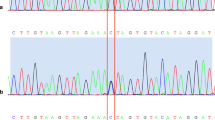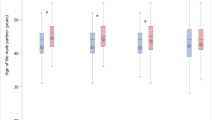Abstract
Purpose
To investigate the occurrence of idiopathic secondary azoospermia (ISA) in men with oligospermia over time and identify risk factors for ISA in this population.
Methods
This was a retrospective cohort study conducted in a university-affiliated male infertility clinic. A total of 1056 oligospermic men (concentration < 15 million/ml (M/ml) and no azoospermia) with at least two SA done between 2000 and 2019 were included. The primary outcome was the occurrence of ISA by oligospermia severity.
Results
In the entire cohort, 31 patients (2.9%) eventually became azoospermic with time. The ≤ 1 M/ml extremely severe oligospermia (ESO) group (283 patients) had significantly higher rates of ISA in each time period compared to the 1–5 M/ml severe oligospermia (SO) (310 patients) and 5–15 M/ml mild oligospermia (MO) (463 patients) groups (p < 0.05 for all comparisons), with rates of 21.1% in the ESO, 4.8% in the SO, and 0% in the MO group (p = 0.02) after 3–5 years, reaching 32% after 5 years in the ESO group compared to no cases in the other two groups (p = 0.006). Parameters shown to predict ISA were initial concentration < 1 M/ml (OR 22.12, p < 0.001) and time interval of > 3 and 5 years (OR 4.83 and 6.84, p = 0.009 and < 0.001, respectively), whereas testosterone levels were negatively associated with ISA (OR 0.88, p = 0.03).
Conclusions
Men with ≤ 1 M/ml, especially those with low testosterone levels, have a dramatically increased chance of becoming azoospermic with time. Therefore, sperm banking should be recommended in these cases. Men with a sperm concentration above 1 M/ml have low chances of becoming azoospermic, even after 3 or more years.

Similar content being viewed by others
Explore related subjects
Discover the latest articles and news from researchers in related subjects, suggested using machine learning.Data availability
The datasets and materials used in this study may be available from the corresponding author upon reasonable request.
References
Zegers-Hochschild F, Adamson GD, de Mouzon J, et al. International committee for monitoring assisted reproductive technology (ICMART) and the world health organization (WHO) revised glossary of ART terminology, 2009. Fertil Steril. 2009;92:1520– 4.
GBD 2017 Population and Fertility Collaborators. Population and fertility by age and sex for 195 countries and territories, 1950–2017: a systematic analysis for the Global Burden of Disease Study 2017. Lancet. 2018;392:1995–2051.
Thonneau P, Marchand S, Tallec A, Ferial ML, Ducot B, Lansac J. Incidence and main causes of infertility in a resident population (1,850,000) of three French regions (1988–1989). Hum Reprod. 1991;6:811–6.
Sharlip ID, Jarow JP, Belker AM, et al. Best practice policies for male infertility. Fertil Steril. 2002;77:873–82.
Jarvi K, Lo K, Grober E, et al. The workup and management of azoospermic males. Can Urol Assoc J. 2015;9:229–35.
Jarow JP, Espeland MA, Lipshultz LI. Evaluation of the azoospermic patient. J Urol. 1989;142:62–5.
Olesen IA, Andersson AM, Aksglaede L, et al. Clinical, genetic, biochemical, and testicular biopsy findings among 1,213 men evaluated for infertility. Fertil Steril. 2017;107:74-82.e7.
Tüttelmann F, Werny F, Cooper TG, Kliesch S, Simoni M, Nieschlag E. Clinical experience with azoospermia: aetiology and chances for spermatozoa detection upon biopsy. Int J Androl. 2011;34:291–8.
Punab M, Poolamets O, Paju P, et al. Causes of male infertility: a 9-year prospective monocentre study on 1737 patients with reduced total sperm counts. Hum Reprod. 2017;32:18–31.
Agarwal A, Baskaran S, Parekh N, et al. Male infertility. Lancet. 2021;397:319–33.
Ma Y, He X, Qi K, et al. Effects of environmental contaminants on fertility and reproductive health. J Environ Sci. 2019;77:210–7.
Taha EA, Ez-Aldin AM, Sayed SK, Ghandour NM, Mostafa T. Effect of smoking on sperm vitality, DNA integrity, seminal oxidative stress, zinc in fertile men. Urology. 2012;80:822–5.
Sharma R, Harlev A, Agarwal A, Esteves SC. Cigarette smoking and semen quality: a new meta-analysis examining the effect of the 2010 World Health Organization laboratory methods for the examination of human semen. Eur J Urol. 2016;70:635–45.
Ricci E, Al Beitawi S, Cipriani S, et al. Semen quality and alcohol intake: a systematic review and meta-analysis. Reprod Biomed Online. 2017;34:38–47.
Gundersen TD, Jørgensen N, Andersson AM, et al. Association between use of marijuana and male reproductive hormones and semen quality: a study among 1,215 healthy young men. Am J Epidemiol. 2015;182:473–81.
Bracken MB, Eskenazi B, Sachse K, McSharry JE, Hellenbrand K, Leo-Summers L. Association of cocaine use with sperm concentration, motility, and morphology. Fertil Steril. 1990;53:315–22.
Eisenberg ML, Kim S, Chen Z, Sundaram R, Schisterman EF, Buck Louis GM. The relationship between male BMI and waist circumference on semen quality: data from the LIFE study. Hum Reprod. 2014;29:193–200.
Gaskins AJ, Afeiche MC, Hauser R, et al. Paternal physical and sedentary activities in relation to semen quality and reproductive outcomes among couples from a fertility center. Hum Reprod. 2014;29:2575–82.
Gomez G, Berger A, Kathrins M. Secondary azoospermia after sleeve gastrectomy: a case report. Ferti Steril Rep. 2021;2:245–8.
Tang D, Li K, Lv M, et al. Altered mRNAs profiles in the testis of patients with “secondary idiopathic non-obstructive azoospermia.” Front Cell Dev Biol. 2022;10:824596.
Nicopoullos JD, Gilling-Smith C, Almeida PA, Norman-Taylor J, Grace I, Ramsay JW. Use of surgical sperm retrieval in azoospermic men: a meta-analysis. Fertil Steril. 2004;82:691–701.
Sousa M, Cremades N, Silva J, et al. Predictive value of testicular histology in secretory azoospermic subgroups and clinical outcome after microinjection of fresh and frozen-thawed sperm and spermatids. Hum Reprod. 2002;17:1800–10.
De Croo I, Van der Elst J, Everaert K, De Sutter P, Dhont M. Fertilization, pregnancy and embryo implantation rates after ICSI in cases of obstructive and non-obstructive azoospermia. Hum Reprod. 2000;15:1383–8.
Tournaye H, Verheyen G, Nagy P, et al. Are there any predictive factors for successful testicular sperm recovery in azoospermic patients? Hum Reprod. 1997;12:80–6.
Cooper TG, Noonan E, von Eckardstein S, et al. World Health Organization reference values for human semen characteristics. Hum Reprod Update. 2010;16:231–45.
Song SH, Bak CW, Lim JJ, Yoon TK, Lee DR, Kwon SW. Natural course of severe oligozoospermia in infertile male: influence on future fertility potential. J Androl. 2010;31:536–9.
Bak CW, Song SH, Yoon TK, Lim JJ, Shin TE, Sung S. Natural course of idiopathic oligozoospermia: comparison of mild, moderate and severe forms. Int J Urol. 2010;17:937–43.
Salas-Huetos A, Rosique-Esteban N, Becerra-Tomás N, Vizmanos B, Bulló M, Salas-Salvadó J. The effect of nutrients and dietary supplements on sperm quality parameters: a systematic review and meta-analysis of randomized clinical trials. Adv Nutr. 2018;9:833–48.
Li KP, Yang XS, Wu T. The effect of antioxidants on sperm quality parameters and pregnancy rates for idiopathic male infertility: a network meta-analysis of randomized controlled trials. Front Endocrinol. 2022;13:810242.
Magdi Y, Darwish E, Elbashir S, Majzoub A, Agarwal A. Effect of modifiable lifestyle factors and antioxidant treatment on semen parameters of men with severe oligoasthenoteratozoospermia. Andrologia. 2017;49.
Karayiannis D, Kontogianni MD, Mendorou C, Douka L, Mastrominas M, Yiannakouris N. Association between adherence to the Mediterranean diet and semen quality parameters in male partners of couples attempting fertility. Hum Reprod. 2017;32:215–22.
Kirby EW, Wiener LE, Rajanahally S, Crowell K, Coward RM. Undergoing varicocele repair before assisted reproduction improves pregnancy rate and live birth rate in azoospermic and oligospermic men with a varicocele: a systematic review and meta-analysis. Fertil Steril. 2016;106:1338–43.
Esteves SC, Miyaoka R, Roque M, Agarwal A. Outcome of varicocele repair in men with nonobstructive azoospermia: systematic review and meta-analysis. Asian J Androl. 2016;18:246–53.
World health organization . WHO Laboratory manual for the examination and processing of human semen. 6th ed. WHO Press; Geneva, Switzerland. 2021. Available online: https://www.who.int/publications/i/item/9789240030787
Author information
Authors and Affiliations
Contributions
G.K., M.S.K., and K.J. designed the study, G.K., S.L., K.C.L, and E.D.G. collected the data. V.M.M. and B.A. interpreted the data; K.L. analyzed the data. G.K., M.S.K., V.M.M., and B.A. drafted the manuscript and G.K. and K.J. revised the draft. All authors reviewed and approved the final manuscript.
Corresponding author
Ethics declarations
Ethics approval
The study was approved by the Research Ethics Board of the Mount Sinai Hospital—reference number 05–0161-E and reference number 07–0032-E on October 18, 2005, for data collection and October 30, 2007, for data analysis, respectively. The REB-approved informed consent form was signed by all participants.
Informed consent
The IRB-approved informed consent was provided by all participants prior to filling out the computer-based survey upon their first visit to the clinic.
Competing interests
The authors declare no competing interests.
Additional information
Publisher's Note
Springer Nature remains neutral with regard to jurisdictional claims in published maps and institutional affiliations.
Rights and permissions
Springer Nature or its licensor (e.g. a society or other partner) holds exclusive rights to this article under a publishing agreement with the author(s) or other rightsholder(s); author self-archiving of the accepted manuscript version of this article is solely governed by the terms of such publishing agreement and applicable law.
About this article
Cite this article
Karavani, G., Kattan, M.S., Lau, S. et al. Idiopathic secondary azoospermia occurrence in men with oligospermia over time. J Assist Reprod Genet 41, 2163–2171 (2024). https://doi.org/10.1007/s10815-024-03179-6
Received:
Accepted:
Published:
Issue Date:
DOI: https://doi.org/10.1007/s10815-024-03179-6




